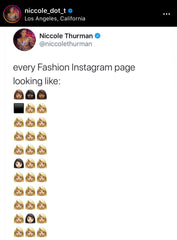Before the infamous black square and “allyship” series of darker complexions made their debuts on beauty brand feeds, the status quo historically perpetuated the glorification of light-skinned beauty. Beauty brands have a huge role to play in ensuring that this moment of reflection transcends hashtags and propels beauty consumption into a new set of celebratory values that also reflects the beauty of Brown and Black women. The tokenization of women of color in moments such as these is nothing new. It’s important we bring to light the many ways in which women of color have been discouraged from appreciating their natural beauty, as well as unpack the dissociation that white supremacy has created between women of color and nature itself.
To achieve this, we turn to the concept of Intersectional Environmentalism. Brought to light by environmental activist Leah Thomas, the term seeks to address the need for an inclusive version of environmentalism that advocates for the protection of both people and the planet. By identifying ways injustices have targeted marginalized communities, we can simultaneously explore how our relationships with the earth are deeply connected.
I was a wee teeny-bopper when I acknowledged that swimming during the summer and UV rays had negative implications on my skin tone, rather than my skin safety. There I was, a tiny sprout on my neighborhood swim team, coming home aware of the casual callouts that were to come regarding the darkness I acquired under the sun. I internalized the thought that playing outside meant rebelling against the notion that tanning wasn’t a good look for me. I had quite the anarchist, tomboy disposition. I learned to revel in my misbehavior, not caring how I looked, rather than learning to bask in my ability to waltz around in perpetual glow.
My short-sighted perspective as a child would be debunked later in life when I would learn that the beauty implications of the foundation counter were just a taste of the prioritization of lighter skin across many facets of a woman’s life. Lighter skin garners the support of higher-paying consumers, causing fashion and beauty leaders to display Black and Brown cultures on white women down runways and in beauty campaigns. Lighter skin has dominated media spaces meant to be more representative of BIPOC cultures. Having darker skin in the healthcare system has negative safety implications for the level of care medical professionals will take when diagnosing you and assessing your needs. Having darker skin makes you a more likely target for sexual harassment and abuse, reflecting the way we over-sexualize women of color and deeply respect the sanctity of whiteness. Having lighter skin can even lead to receiving less prison time. Now, tell me that the way brands value and portray beauty doesn’t have large implications for the way women exist in this world.
Even with the awareness that has come with age, we still run our fingers along calm waters nearby and watch water droplets glisten in the sun as they run off our arms, feeling youthful rebellion warm our bodies as they golden. Sounds like quite the beauty campaign, right?
Harnessing people of color in the beauty industry means celebrating our resistance in solidarity. Show our brown hands holding your latest product, and make sure the development of that product doesn’t exploit our people.
Showcase brown skin glowing naturally under the sun, supported by the emphasis your products can bring.

Tell people of color that we deserve to breathe fresh air wading amidst trees by creating art that tells that story.
Partner with us to make sure the story you want to tell showcases how connected we are to mother nature, to madre tierra, as people of color.
And when you build these campaigns, organize these photoshoots, select influencers, and tell our stories, make sure you are showcasing that our skin comes in many beautiful shades.
By: Diandra Marizet







